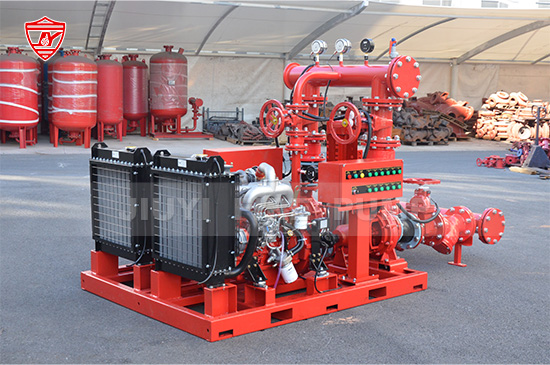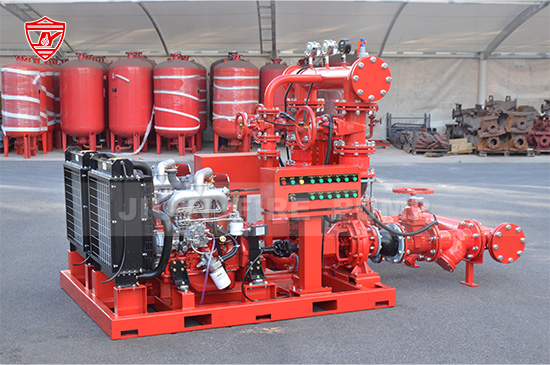Selecting a UL fire pump set for an industrial plant is one of the most critical decisions in designing a reliable fire protection system. Industrial facilities—such as chemical plants, manufacturing sites, oil and gas terminals, logistics warehouses, steel factories, and power stations—carry higher fire risks and require pumps that can deliver certified performance under emergency conditions.
In this article, we provide a complete, detailed guide on how to choose the right UL listed fire pump set for industrial projects, covering design requirements, pump sizing, driver selection, system components, installation considerations, and long-term maintenance.
As a manufacturer of UL fire pumps, we aim to help engineers, consultants, and project managers make informed decisions to ensure both compliance and safety.

Under NFPA 20, fire pumps must deliver dependable water flow and pressure during fire events. However, in high-risk industrial environments, performance must be guaranteed, not just projected.
A UL listed fire pump ensures:
Verified performance through independent testing
Compliance with globally recognized NFPA 20 standards
Reliable operation under real fire conditions
Reduced risk of system failure
Increased approval likelihood by insurers, consultants, and AHJs
For factories or industrial plants, insurance companies often require UL/FM certified pumps. Using non-certified pumps may reduce initial cost but increases long-term risk and potentially voids insurance coverage in the event of fire.
Before selecting any UL fire pump set, engineers must first determine the fire protection water demand. This is typically based on:
Building type and fire hazard classification
Sprinkler system design (CMDA, ESFR, CMSA, deluge, etc.)
Local fire code requirements
Required duration of water supply
Presence of fire hydrants, monitors, or foam systems
Key parameters that must be known:
Required flow (GPM or L/min)
Required pressure (PSI or bar)
Net pressure available from the water source
Pump room layout and available space
Industrial plants often demand higher capacities, commonly:
500–3000 GPM for sprinkler systems
2000–5000 GPM for combined hydrant and sprinkler systems
2500–6000 GPM for petroleum or chemical sites
Once demand is known, engineers can begin selecting the appropriate UL fire pump model and driver.
NFPA 20 allows multiple pump types to be UL listed. The most common options for industrial facilities include:
Suitable for moderate flows up to around 750–1000 GPM.
Ideal for compact pump rooms or small industrial facilities.
Most popular for industrial projects due to high reliability.
Advantages include:
High efficiency
Longer service life
Easy maintenance
Flow capacities from 500–5000+ GPM
This is the most recommended type for large plants.
Best for sites with water drawn from:
Groundwater wells
Lakes
Rivers
Open reservoirs
Vertical turbine pumps are mandatory when the water source is below pump suction level.
Used in high-pressure applications or tall structures.
Suitable for industrial plants with multi-level fire systems.
When selecting pump types, consider water source, required performance, and maintenance accessibility.
Correct pump sizing is crucial for ensuring fire protection systems operate effectively.
NFPA 20 requires pumps to supply the system demand at minimum flow, but with safety margin. For industrial systems:
Choose pump flow equal to or slightly above system demand
Avoid oversizing (causes churn heating and energy waste)
Typical industrial flows range from 1000–3000 GPM. Select the closest UL certified flow rating.
Pump pressure must overcome:
System pressure demand
Elevation difference
Friction losses in piping
Hose stream demand for hydrant systems
Common industrial pressures are 100–200 PSI. Determine the target discharge pressure based on worst-case scenario.
Review the UL-approved pump curve carefully to confirm:
Rated pressure at 100% flow
115% pressure requirement at 100% flow (UL rule)
65% pressure at 150% flow
Driver selection depends on site conditions, power reliability, and regulatory requirements.
Advantages:
Lower maintenance
Stable performance
Lower noise
Cost-effective for continuous power sites
Recommended when electrical power supply is stable and meets NFPA 20 requirements.
Advantages:
Independence from electrical grid
Ideal for remote or unstable power environments
Mandatory in some high-risk facilities
Industrial plants with unreliable power or high outage risk—such as manufacturing parks, chemical plants, and offshore facilities—commonly choose diesel-driven UL pumps.
NFPA 20 also requires specific components for diesel UL sets, including:
Two storage batteries
Fuel tank sized for minimum 8 hours
Battery charger
Engine cooling system
A complete UL fire pump set includes more than just the pump and driver. Engineers must ensure the entire system complies with NFPA 20.
Essential components:
UL listed pump
UL listed electric motor or diesel engine
UL listed controller
Jockey pump and controller
Base frame and coupling
Automatic valves and fittings
Pressure gauges
Relief valve (when required)
Suction and discharge piping arrangement
Flow test device (test header or flowmeter)
For industrial plants, a packaged fire pump system is often preferred because:
It reduces installation time
Ensures proper alignment and compliance
Simplifies inspection and testing
Improves overall reliability
Controllers are critical because they start and operate the pump during emergencies. For UL fire pump sets, the controller must also be UL listed.
Two main types:
Electric motor controllers
Diesel engine controllers
Key features to evaluate:
Automatic and manual start
Sequential start for multiple pumps
Emergency shutdown
Pressure switches
Remote monitoring capability
In industrial plants requiring high uptime, consider controllers with enhanced diagnostics and event reporting.
Proper installation ensures the pump delivers certified performance.
Key factors:
Pump room must be accessible and protected
Maintain required clearances for maintenance
Provide adequate ventilation (especially for diesel pumps)
Ensure correct suction piping layout (straight run, no high points)
Install vibration isolation to protect piping
Follow NFPA 20 requirements for valves, gauges, and fittings
UL fire pump sets must be installed exactly as per certification guidelines to avoid invalidating compliance.
Before handing over the system, the UL fire pump must be tested.
Essential procedures include:
No-flow (churn) test
100% rated flow test
150% rated flow test
Alarm and controller test
Diesel engine start and transfer test
Record the pump curve to confirm it matches UL performance. Any major deviation requires corrective action.
Industrial fire pump systems must be maintained to ensure readiness. Recommended practices include:
Weekly:
Diesel engine test
Controller inspection
Visual checks
Monthly:
Jockey pump operation
Battery maintenance
Pressure switch checks
Annual:
Full flow test
Controller function test
Valve inspection
Pump room safety inspection
Factories with high-risk operations may conduct more frequent checks.
Selecting the right manufacturer is as important as selecting the pump.
A reliable UL fire pump supplier should offer:
Full UL certified pump ranges
Diesel and electric options
Packaged fire pump systems
Strong engineering support
Proper documentation for contractors and consultants
Technical assistance for installation and commissioning
Industrial plants benefit from suppliers who can provide long-term service, spare parts, and technical guidance—not just a pump.

Choosing the right UL fire pump set is essential for protecting industrial facilities that face high fire risks. Engineers must evaluate water demand, pump type, performance requirements, driver selection, UL certification, NFPA 20 compliance, installation conditions, and long-term maintenance needs.
A carefully selected UL listed fire pump system not only ensures operational reliability but also helps industrial plants meet insurance requirements, minimize downtime, and enhance overall fire safety.